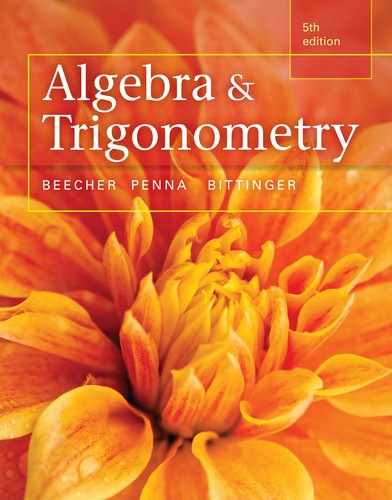3.4 Solving Rational Equations and Radical Equations
Solve rational equations.
Solve radical equations.
Rational Equations
Equations containing rational expressions are called rational equations. Solving such equations involves multiplying on both sides by the least common denominator (LCD) of all the rational expressions to clear the equation of fractions.
Example 1
Solve: x−83+x−32=0
The zero of the function is 5. Thus the solution of the equation is 5.
Now Try Exercise 3.
Caution!
Clearing fractions is a valid procedure when solving rational equations but not when adding, subtracting, multiplying, or dividing rational expressions. A rational expression may have operation signs but it will have no equals sign. A rational equation always has an equals sign. For example, x−83+x−32
To simplify the rational expression x−83+x−32
To solve the rational equation x−83+x−32=0
When we use the multiplication principle to multiply (or divide) on both sides of an equation by an expression with a variable, we might not obtain an equivalent equation. We must check the possible solutions obtained in this manner by substituting them in the original equation. The next example illustrates this.
Example 2
Solve: x2x−3=9x−3
Solution
The LCD is x−3
The possible solutions are −3 and 3. We check.
Check:
For −3

For 3

The number −3 checks, so it is a solution. Since division by 0 is not defined, 3 is not a solution. Note that 3 is not in the domain of either x2/(x−3)
Now Try Exercise 9.
Example 3
Solve: 23x+6+1x2−4=4x−2
Solution
We first factor the denominators in order to determine the LCD:
The possible solution is −52
Now Try Exercise 21.
Radical Equations
A radical equation is an equation in which variables appear in one or more radicands. For example,
is a radical equation. The following principle is used to solve such equations.
Example 4
Solve: √3x+1=4
Solution
We have
Check:

The solution is 5.
Now Try Exercise 31.
In Example 4, the radical was isolated on one side of the equation. If this had not been the case, our first step would have been to isolate the radical. We do so in the next example.
Example 5
Solve: 5+√x+7=x
Now Try Exercise 55.
When we raise both sides of an equation to an even power, the resulting equation can have solutions that the original equation does not. This is because the converse of the principle of powers is not necessarily true. That is, if an=bn
When a radical equation has two radical terms on one side, we isolate one of them and then use the principle of powers. If, after doing so, a radical term remains, we repeat these steps.
Example 6
Solve: √x−3+√x+5=4.
Solution
We have
The number 4 checks. It is the solution.
Now Try Exercise 65.
3.4 Exercise Set
Solve.
1. 14+15=1t
2. 13−56=1x
3. x+24−x−15=15
4. t+13−t−12=1
5. 12+2x=13+3x
6. 1t+12t+13t=5
7. 53x+2=32x
8. 2x−1=3x+2
9. y2y+4=16y+4
10. 49w−7=w2w−7
11. x+6x=5
12. x−12x=1
13. 6y+3+2y=5y−3y2−9
14. 3m+2+2m=4m−4m2−4
15. 2xx−1=5x−3
16. 2xx+7=5x+1
17. 2x+5+1x−5=16x2−25
18. 2x2−9+5x−3=3x+3
19. 3xx+2+6x=12x2+2x
20. 3y+5y2+5y+y+4y+5=y+1y
21. 15x+20−1x2−16=3x−4
22. 14x+12−1x2−9=5x−3
23. 25x+5−3x2−1=4x−1
24. 13x+6−1x2−4=3x−2
25. 8x2−2x+4=xx+2+24x3+8
26. 18x2−3x+9−xx+3=81x3+27
27. xx−4−4x+4=32x2−16
28. xx−1−1x+1=2x2−1
29. 1x−6−1x=6x2−6x
30. 1x−15−1x=15x2−15x
31. √3x−4=1
32. √4x+1=3
33. √2x−5=2
34. √3x+2=6
35. √7−x=2
36. √5−x=1
37. √1−2x=3
38. √2−7x=2
39. 3√5x−2=−3
40. 3√2x+1=−5
41. 4√x2−1=1
42. 5√3x+4=2
43. √y−1+4=0
44. √m+1−5=8
45. √b+3−2=1
46. √x−4+1=5
47. √z+2+3=4
48. √y−5−2=3
49. √2x+1−3=3
50. √3x−1+2=7
51. √2−x−4=6
52. √5−x+2=8
53. 3√6x+9+8=5
54. 5√2x−3−1=1
55. √x+4+2=x
56. √x+1+1=x
57. √x−3+5=x
58. √x+3−1=x
59. √x+7=x+1
60. √6x+7=x+2
61. √3x+3=x+1
62. √2x+5=x−5
63. √5x+1=x−1
64. √7x+4=x+2
65. √x−3+√x+2=5
66. √x−√x−5=1
67. √3x−5+√2x+3+1=0
68. √2m−3=√m+7−2
69. √x−√3x−3=1
70. √2x+1−√x=1
71. √2y−5−√y−3=1
72. √4p+5+√p+5=3
73. √y+4−√y−1=1
74. √y+7+√y+16=9
75. √x+5+√x+2=3
76. √6x+6=5+√21−4x
77. x1/3=−2
78. t1/5=2
79. t1/4=3
80. m1/2=−7
Solve.
81. P1V1T1=P2V2T2, for T1 (A chemistry formula for gases)
82. 1F=1m+1p, for F (A formula from optics)
83. W=√1LC, for C (An electricity formula)
84. s=√A6, for A (A geometry formula)
85. 1R=1R1+1R2, for R2 (A formula for resistance)
86. 1t=1a+1b, for t (A formula for work rate)
87. I=√AP−1, for P (A compound-interest formula)
88. T=2π√1g, for g (A pendulum formula)
89. 1F=1m+1p, for p (A formula from optics)
90. V2R2=2gR+h, for h (A formula for escape velocity)
Skill Maintenance
Find the zero of the function. [1.5]
91. f(x)=15−2x
92. f(x)=−3x+9
Solve. [1.5]
93. Pork Production. Together, China and the United States, the top two pork producers worldwide, produced 64,308,000 metric tons of pork in 2013. China produced 1,260,000 metric tons more than five times the number of metric tons produced by the United States. (Source: United Nations Food and Agriculture Organization) How many metric tons of pork did each country produce in 2013?

94. Sports Injuries. In 2012 in the United States, there were 172,470 injuries among soccer players ages 19 and under. This was about 44% more than the number of injuries among baseball players ages 19 and under. (Source: Safe Kids Worldwide, based on hospital ER reports, 2012) How many baseball players ages 19 and under were injured in 2012?
Synthesis
Solve.
95. (x−3)2/3=2
96. x+3x+2−x+4x+3=x+5x+4−x+6x+5
97. √x+5+1=6√x+5
98. √15+√2x+80=5
99. x2/3=x
